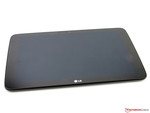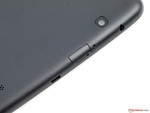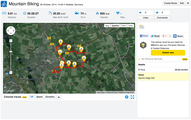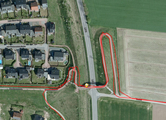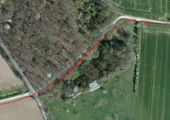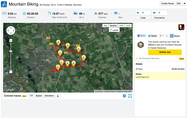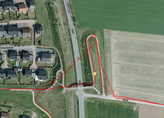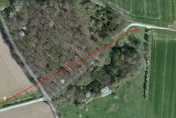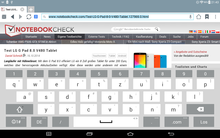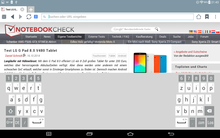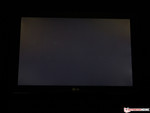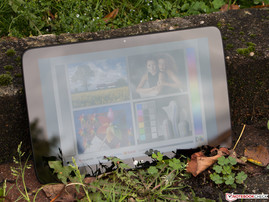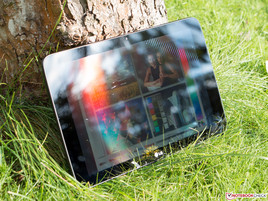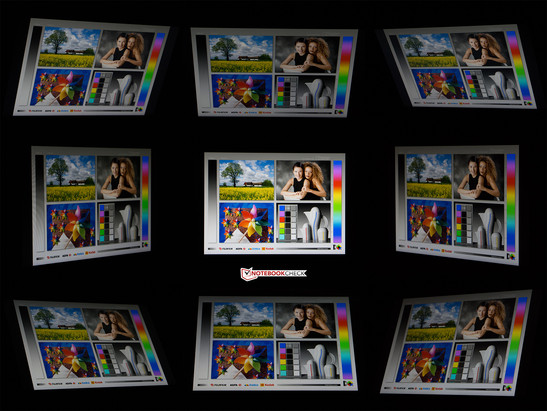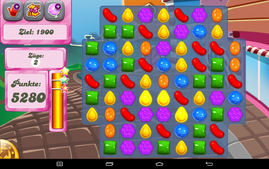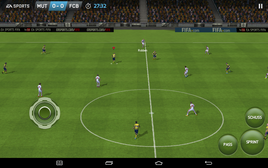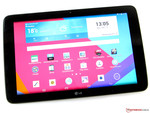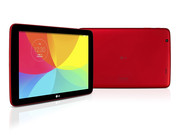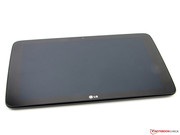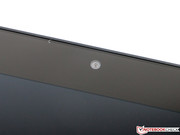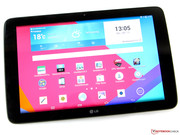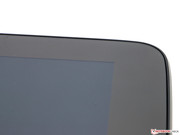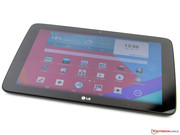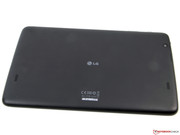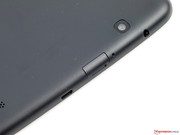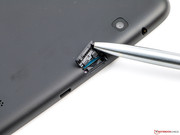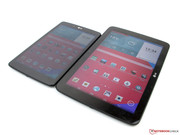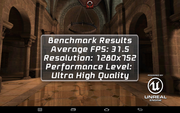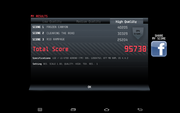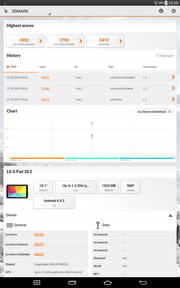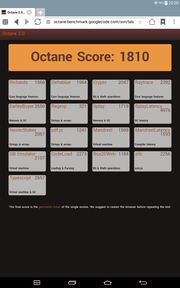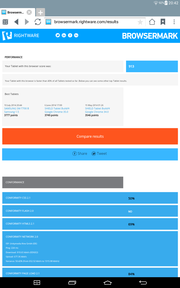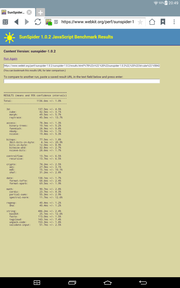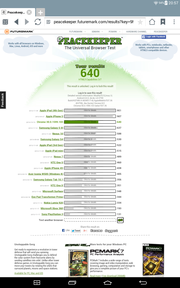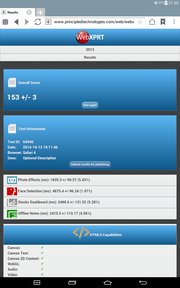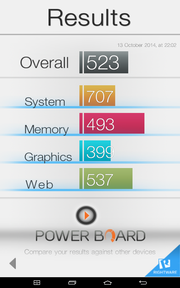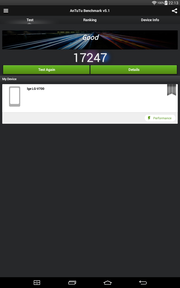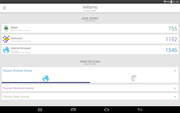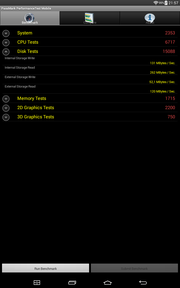Test: LG G Pad 10.1 V700 (sammanfattning)

For the original German review, see here.
LG's G Pad 10.1 V700 is actually an elongated G Pad 8.0. The hardware specifications are virtually identical. A similar Snapdragon 400 processor is used, 16 GB of internal storage is on board, and the latest Android 4.4 KitKat is installed. The exterior size has increased due to the 10.1-inch (~25.6 cm) touchscreen, and the battery is larger. It is also equipped with a micro-SD card reader, which only supports memory cards with a capacity up to 32 GB. G Pad accepts cards with a maximum of 64 GB. The manufacturer’s selling price for the device is 299 Euros (~$380) RRP.
There are plenty of competitors. We used Samsung's Galaxy Tab 4 10.1 (starts at 305 Euros; ~$384), Lenovo's Yoga 10 HD+ (starts at 299 Euros; ~$380), Gigaset's QV1030 (starts at 180 Euros; ~$229), and Microsoft's Surface 2 (starts at 309 Euros; ~$393) for comparison. The tablets from Lenovo and Microsoft are more expensive, but their prices have dropped in the meantime so that they are strong alternatives.
Case
LG's G Pad 10.1 is one of the slimmer members of the 10-inch category. Its particularly thin display bezel makes it even more compact than http://www.notebookcheck.net/Review-Sony-Xperia-Z2-Tablet.116284.0.htmlSony's Xperia Z2 tablet. The review sample does not even reach a height of nine millimeters (~0.35 inches), but cannot compete with Sony's top model (6.4 mm; ~0.25 inches) here. It is also quite light with 512 grams (~1.13 lb).
The rubberized back cover is available in black and red, and looks impressive, although every fingerprint is visible on it. The gaps are even, but the casing could close more flush with the screen. It is easy to slip a piece of paper between them.
The tablet is quite pressure sensitive. No matter whether on the back, or on the screen itself, waves are relatively easy to provoke. The device is also comparatively easy to twist and produces a clearly audible cracking noise as well as a rustling sound from the inside.
The micro-SD slot's flap closes flush with the surrounding casing, and is easy to open and close. The integrated battery cannot be exchanged.
Connectivity
The micro-USB 2.0 port in LG's G Pad 10.1 is used for both recharging the tablet, and sharing data with a computer. The interface supports OTG, but not MHL for transmitting images.
The micro-SD card reader supports memory cards with a capacity of up to 32 GB (SDHC). This step backwards, compared with the smaller G Pad 8.0 model, that is compatible with the SDXC standard (max. 64 GB), did not seem logical to us. Therefore, we inserted a micro-SD card from Samsung (SDXC, 64 GB, UHS-I). It was detected as invalid.
An infrared transmitter is also installed, and enables controlling TVs, Blu-ray and DVD drives. Both DLNA and Miracast are available for wireless transmission of media or videos.
Software
Google's Android 4.4.2 KitKat operating system is used. LG has modified the interface, and it blends in well with the overall concept of LG's product line. The G Pad 10.1 also completely exhausts the proprietary software features. Besides Knock Code, QPair, and Quick Remote, Dual Windows for multitasking is also available. These features are already known from LG's G Pad 8.0 and G3, where more details can be found.
Communication & GPS
The Wi-Fi module in LG's G Pad 10.1 supports the IEEE 802.11 a/b/g/n standards, and therefore transmits in both the 2.4 and 5.0 GHz frequency ranges. Its range is really good. The signal strength was still good and browsing on the Internet was possible without noticeable speed decreases even at a distance of 25 meters (~82 ft) from the router (Fritz!Box 6360, 2.4 GHz) and through one exterior wall. The manufacturer does not offer an LTE version.
Bluetooth 4.0 is also installed, and works as intended. Music and sound of streamed HD videos from the Internet are transmitted impeccably to external speakers. However, a short noise and subsequent "snap" are heard when sound transmission is finished. Then the speaker goes silent.
LG's G Pad 10.1 uses both GPS and Glonass for locating position. A satellite was found almost instantaneously outdoors. As expected, the signal was weaker indoors, and it took slightly longer to fix the location.
The tablet's accuracy was not quite as good on a tight road or under difficult conditions, such as in the woods. It cannot compete with our Garmin Edge 500 bike computer. However, the discrepancies are below 3% when looking at the entire route, which is a fairly good result.
Cameras
LG's G Pad 10.1 is equipped with the same camera features as the G Pad 8.0, and thus the performance of the lenses is identical. The front-facing camera has a resolution of 1.2 megapixels (1280x800 pixels; 16:9), and is suitable for video conferencing in good light conditions.
The rear-facing primary camera supports up to 5 megapixels (2560x1920 pixels; 4:3), and provides rich colors. The sharpness could be better. Details are muddy and outlines look slightly frayed when looked at more closely. The pictures exhibit a strong noise in weak light, and the sharpness deteriorates even more. An auxiliary light or flash is not installed for brightening up light conditions.
Videos can be recorded in Full HD. However, the quality is also only average here. Panning or fast-moving objects can hardly be captured, and the sound is also not very satisfactory.
Accessories
The accessories included with LG's G Pad 10.1 comprise of a modular power supply (5 volts, 1.8 ampere) with an output of 8 Watts, a USB data cable, and a quick start guide.
The manufacturer does not offer any optionally purchasable, tablet-specific accessories.
Warranty
LG includes a 24-month warranty on its G Pad 10.1. The accessories are covered for twelve months. The warranty cannot be upgraded.
Input Devices & Controls
The capacitive touchscreen in LG's G Pad 10.1 detects up to ten simultaneous inputs. The surface has good gliding properties, and implements inputs accurately. However, the tablet sometimes needs a moment before responding. This could be due to the weaker SoC because this is seldom the case with the Android interface, and mostly occurs in apps.
The device utilizes LG's Smart Keyboard with a well designed keyboard layout. The user can customize it to meet personal needs. For example, the key size can be adjusted and a key with an additional special character can be placed beside the space bar in the settings. The split keyboard, as known from devices based on Windows 8, is particularly convenient for this large screen size because all characters can be reached with the thumbs. However, they are much smaller.
Display
LG's G Pad 10.1 has a 10.1-inch, IPS screen with a resolution of 1280x800 pixels. This corresponds to an aspect ratio of 16:10 and pixel density of a meager 150 ppi. Even the lettering on the home screen seems slightly out of focus and pixelation is visible when looking closely. Ironically, the cheapest device in the comparison field also has the highest resolution. The Gigaset QV1030 provides razor-sharp 229 ppi (10.1 inches, 2560x1600 pixels).
The screen's maximum brightness of 360 cd/m² is quite decent, though the illumination of 84% is only average. All competitors do a better job in distributing the brightness, and achieve at least 86%. Samsung's Galaxy Tab 4 10.1 can even boast with very good 92%.
LG's G Pad 10.1 struggles with a few illumination issues. Firstly, the small halos that are only visible on dark content. Then, the screen's brightness is dimmed automatically when the SoC is loaded to prevent overheating. We experienced brightness drops from 100% to 81% in such cases. Since neither the screen nor the SoC are particularly power-hungry products that generate high waste heat, it can only be a bug in the management software. We observed a similar issue in LG's G3, where poor engineering was the cause of the screen's brightness dropping to 191 cd/m². In addition, there is no ambient light sensor.
| |||||||||||||||||||||||||
Distribution av ljusstyrkan: 84 %
Mitt på batteriet: 360 cd/m²
Kontrast: 439:1 (Svärta: 0.82 cd/m²)
ΔE ColorChecker Calman: 5.56 | ∀{0.5-29.43 Ø4.78}
ΔE Greyscale Calman: 3.59 | ∀{0.09-98 Ø5}
Gamma: 2.02
CCT: 6483 K
| LG G Pad 10.1 V700 Adreno 305, 400 APQ8026, 16 GB eMMC Flash | Samsung Galaxy Tab 4 10.1 Adreno 305, 400 MSM8226, 16 GB SSD | Gigaset QV1030 GeForce Tegra 4, 4, 16 GB eMMC Flash | Lenovo Yoga Tablet 10 HD+ Adreno 305, 400 APQ8028, 16 GB eMMC Flash | Microsoft Surface 2 GeForce Tegra 4, 4, 32 GB eMMC Flash | |
|---|---|---|---|---|---|
| Screen | 7% | 17% | 25% | 25% | |
| Brightness middle (cd/m²) | 360 | 418 16% | 362 1% | 388 8% | 357 -1% |
| Brightness (cd/m²) | 331 | 402 21% | 342 3% | 374 13% | 369 11% |
| Brightness Distribution (%) | 84 | 92 10% | 86 2% | 87 4% | 89 6% |
| Black Level * (cd/m²) | 0.82 | 0.61 26% | 0.5 39% | 0.36 56% | 0.51 38% |
| Contrast (:1) | 439 | 685 56% | 724 65% | 1078 146% | 700 59% |
| Colorchecker dE 2000 * | 5.56 | 6.52 -17% | 4.75 15% | 5.28 5% | 3.86 31% |
| Greyscale dE 2000 * | 3.59 | 5.92 -65% | 3.93 -9% | 5.6 -56% | 2.4 33% |
| Gamma | 2.02 109% | 3.58 61% | 2.48 89% | 2.66 83% | 2.46 89% |
| CCT | 6483 100% | 6511 100% | 6565 99% | 6631 98% | 6740 96% |
* ... mindre är bättre
The black level of LG's G Pad 10.1 is somewhat high with 0.82 cd/m². Consequently, black looks rather grayish. The contrast is correspondingly low, and just achieves 439:1. All other competitors in the comparison do a better job. In front is the Yoga Tablet 10 HD+ (0.36 cd/m²; 1078:1) with excellent rates.
The review sample's color accuracy is considerably better. The shifts in the grayscale are marginal (dE 3.6). They are somewhat higher in the mixed colors, and reach an average DeltaE rate of 5.6. The red and blue hues deviate partially from the ideal. This is also reflected in color accuracy and saturation, where magenta and cyan exhibit the highest shifts. However, the majority of users will not notice this in practice.
LG's G Pad 10.1 struggles with the same problems as the smaller G Pad 8.0 in the outdoors. The review sample's contrast is even lower. The content is legible in the shade, although the highly reflective screen is disturbing to the eyes. It becomes even more difficult in sunlight. The likelihood that the screen's maximum brightness will not be available will increase in the summer when the temperatures are higher.
LG's G Pad 10.1 has very stable viewing angles. This is primarily due to the underlying IPS technology. A slight loss in brightness started at approximately 45 degrees. The content was displayed stably even in extremely flat angles, and we did not notice any ghosting effect.
Performance
Calculations are performed by a Qualcomm Snapdragon 400 APQ8026. The quad-core processor clocks with 1.2 GHz, and is the counterpart to the Snapdragon 400 MSM8226 in the G Pad 8.0, only it does not have the ability to connect to the Internet using a mobile network. Once again, a 1 GB working memory is installed, and the SoC-integrated Qualcomm Adreno 305 is responsible for graphic computations. The system largely runs smoothly, but the user will have to expect minor stutters.
We obtained relatively good scores in the benchmarks. However, AnTuTu v4 makes it clear that the SoC is no longer one of the fastest of its kind. The Tegra 4 in Gigaset's QV1030 is 74% faster, and does not belong to the premium range anymore. Even the tablets with the stronger Nvidia GPU have a clearer lead in GFXBench 2.7. The difference is particularly evident in the off-screen test, where the Surface 2 and QV1020 are roughly three times as fast. Also, the frame rates in Epic Citadel Ultra High Test demonstrates that the graphics unit is coming close to its limits. New interfaces, such as OpenGL ES 3.0 and 3.1, are not even supported from the outset.
| AnTuTu v4 - Total Score (sortera efter värde) | |
| LG G Pad 10.1 V700 | |
| Samsung Galaxy Tab 4 10.1 | |
| Lenovo Yoga Tablet 10 HD+ | |
| Gigaset QV1030 | |
| Geekbench 2 - 32 Bit - Total Score (sortera efter värde) | |
| LG G Pad 10.1 V700 | |
| Google Nexus 10 | |
| Samsung Galaxy Tab 4 10.1 | |
| Lenovo Yoga Tablet 10 HD+ | |
| 3DMark | |
| 1280x720 Ice Storm Standard Score (sortera efter värde) | |
| LG G Pad 10.1 V700 | |
| Samsung Galaxy Tab 4 10.1 | |
| Lenovo Yoga Tablet 10 HD+ | |
| 1280x720 Ice Storm Standard Graphics (sortera efter värde) | |
| LG G Pad 10.1 V700 | |
| Samsung Galaxy Tab 4 10.1 | |
| Lenovo Yoga Tablet 10 HD+ | |
| 1280x720 Ice Storm Standard Physics (sortera efter värde) | |
| LG G Pad 10.1 V700 | |
| Samsung Galaxy Tab 4 10.1 | |
| Lenovo Yoga Tablet 10 HD+ | |
| GFXBench (DX / GLBenchmark) 2.7 | |
| T-Rex Onscreen (sortera efter värde) | |
| LG G Pad 10.1 V700 | |
| Google Nexus 10 | |
| Samsung Galaxy Tab 4 10.1 | |
| Lenovo Yoga Tablet 10 HD+ | |
| Microsoft Surface 2 | |
| Gigaset QV1030 | |
| 1920x1080 T-Rex Offscreen (sortera efter värde) | |
| LG G Pad 10.1 V700 | |
| Google Nexus 10 | |
| Samsung Galaxy Tab 4 10.1 | |
| Lenovo Yoga Tablet 10 HD+ | |
| Microsoft Surface 2 | |
| Gigaset QV1030 | |
| Epic Citadel | |
| Ultra High Quality (sortera efter värde) | |
| LG G Pad 10.1 V700 | |
| Lenovo Yoga Tablet 10 HD+ | |
| High Quality (sortera efter värde) | |
| LG G Pad 10.1 V700 | |
| Lenovo Yoga Tablet 10 HD+ | |
The browsing speed of LG's G Pad 10.1 is adequate, but cannot be called exceptionally fast. We performed the benchmarks using the stock browser that is based on Google Chrome 30. However, the review sample fares a bit better when compared to devices with a similar hardware, such as the Galaxy Tab 4 10.1. Nevertheless, users should reckon on longer waiting times for sophisticated websites to load.
| Octane V2 - Total Score (sortera efter värde) | |
| LG G Pad 10.1 V700 | |
| Samsung Galaxy Tab 4 10.1 | |
| Lenovo Yoga Tablet 10 HD+ | |
| Microsoft Surface 2 | |
| Gigaset QV1030 | |
| Peacekeeper - --- (sortera efter värde) | |
| LG G Pad 10.1 V700 | |
| Google Nexus 10 | |
| Lenovo Yoga Tablet 10 HD+ | |
| Microsoft Surface 2 | |
| Mozilla Kraken 1.1 - Total (sortera efter värde) | |
| LG G Pad 10.1 V700 | |
| Samsung Galaxy Tab 4 10.1 | |
| Microsoft Surface 2 | |
| Sunspider - 1.0 Total Score (sortera efter värde) | |
| LG G Pad 10.1 V700 | |
| Samsung Galaxy Tab 4 10.1 | |
| Lenovo Yoga Tablet 10 HD+ | |
| Microsoft Surface 2 | |
| Gigaset QV1030 | |
* ... mindre är bättre
LG's G Pad 10.1 has a 16 GB flash storage. The user can use 10.82 GB of that. It can be expanded by up to 32 GB via a micro-SD when more storage is needed. Applications can also be copied to the memory card and used from there as the system supports App2SD.
The flash storage speed is relatively fast, and is good in most areas. The review sample is only midfield when it comes to writing large files.
Games
The former mid-range Adreno 305 GPU now belongs to the performance-weaker division. Nevertheless, tracks that only require low performance are no problem for LG's G Pad 10.1. The user will not notice the limited power in games like Candy Crush or Angry Birds. Owing to the screen's low resolution, current games like FIFA 15 UT are no problem and can be played smoothly. However, the user will soon get annoyed with lags in hardware-intensive games like Asphalt 8. However, neither the touchscreen, nor the impeccably functioning sensors will ruin the fun.
Emissions
Temperature
LG's G Pad 10.1 achieves surface temperatures of up to 35.6 °C (~96 °F) while idling, and is thus comparatively warm. Only Gigaset's QV1030 (35.4 °C; ~95.7 °F) achieves a similar temperature. The review sample's rates climb up to 40 °C (~104 °F) during load. The QV1030 (41 °C; ~105.8 °F) is the only device in the comparison group that gets even warmer. All other competitors stay below 40 degrees (~104 °F). However the results show absolutely no cause for criticism.
We check the performance stability during permanent load with the battery test of GFXBench 3.0. The app runs its on-screen test thirty times in succession, and records both the battery state and frame rates. LG's G Pad 10.1 could maintain its performance stably over the entire period. It is aggravating that the screen's brightness is throttled to 81% (191 cd/m²).
(±) Den maximala temperaturen på ovansidan är 40 °C / 104 F, jämfört med genomsnittet av 33.7 °C / 93 F , allt från 20.7 till 53.2 °C för klassen Tablet.
(+) Botten värms upp till maximalt 39.4 °C / 103 F, jämfört med genomsnittet av 33.2 °C / 92 F
(+) Vid tomgångsbruk är medeltemperaturen för ovansidan 29.2 °C / 85 F, jämfört med enhetsgenomsnittet på 30 °C / ### class_avg_f### F.
Speakers
The two speakers at the back of LG's G Pad 10.1 have been poorly positioned, and are quickly covered when held in the hands. The tablet's volume can also be turned up to quite an extent. However, the trebles greatly overdrive and distort. The sound is comparatively good in medium volume, and even the bass is audible. Playback using the audio jack does not give any reason for complaint subjectively, and makes a good impression.
Energy Management
Battery Runtime
We struggled with the same issues in LG's G Pad 10.1 as previously in the G Pad 8.0, and could not obtain any useful power consumption data. However, we noticed that the battery did drain to some extent and that the charge state dropped by two percentage points during the benchmarks that we performed with a connected power supply. The power supply (5 volt, 1.8 ampere) output of 9 Watts is apparently too low.
On the other hand, the battery's capacity of 8000 mAh is quite generous, and enables a very good battery life. Both the minimum and maximum runtimes we obtained, provided good results. The rates determined using a screen brightness of 150 cd/m² provides a better comparison basis. The Wi-Fi and video playback times are really good, and are only exceeded by the Yoga Tablet 10 HD+.
| LG G Pad 10.1 V700 Adreno 305, 400 APQ8026, 16 GB eMMC Flash | Samsung Galaxy Tab 4 10.1 Adreno 305, 400 MSM8226, 16 GB SSD | Gigaset QV1030 GeForce Tegra 4, 4, 16 GB eMMC Flash | Lenovo Yoga Tablet 10 HD+ Adreno 305, 400 APQ8028, 16 GB eMMC Flash | Microsoft Surface 2 GeForce Tegra 4, 4, 32 GB eMMC Flash | |
|---|---|---|---|---|---|
| Batteridrifttid | -37% | -42% | 0% | -34% | |
| Reader / Idle (h) | 28.3 | 15.7 -45% | 22.6 -20% | 18.3 -35% | |
| H.264 (h) | 13 | 9.6 -26% | 14.2 9% | 12.2 -6% | |
| WiFi (h) | 12.9 | 10.4 -19% | 8.7 -33% | 15.8 22% | 8 -38% |
| Load (h) | 7.4 | 3.2 -57% | 3.7 -50% | 6.6 -11% | 3.3 -55% |
Verdict
Alla som plockar upp LG:s G Pad 10.1 för första gången blir förvånad över hur kompakt en 10-tums surfplatta kan vara. Den är skön att hålla i och batteriet räcker länge. Dessutom ger LG:s egna program faktiskt mervärde.
Tyvärr har inte skärmen särskilt hög upplösning, och surfplattan kan inte behålla skärmens maximala ljusstyrka under permanent belastning. Det senare begränsar användbarheten i direkt solljus. Den saknar dessutom sensor för omgivande ljus. Synd, eftersom Wi-Fi-räckvidden passar bra för användning i trädgården. Vi gör avdrag för den nackdelen.
Processorn är ingen högpresterande modell. Användare som gillar grafiskt krävande spel bör undvika plattan, men prestandan räcker för allt annat. HD-video fungerar också smidigt. Surfplattan är alltså ett bra val för alla som huvudsakligen tänkt använda den för medieuppspelning och kommunikationsappar.




